|
|
|
|
Panasonic Toughbook 31
Much more performance, great battery life, a super-bight display and many new features mark the 6th generation of Panasonic's milestone rugged notebook computer platform
(by Conrad H. Blickenstorfer; photography by Carol Cotton)
Update September 18, 2012: Following upgrades to the Panasonic Toughbook 19 fully rugged convertible tablet PC, the Toughbook 31 rugged notebook also received substantial tech upgrades. First and foremost, there are now Intel 3rd generation processors (i5-3360M, i5-3320M, and i3-3110M), boosting graphics performance (by a lot), overall performance, and boost battery life. i5 models now have 500GB 7,200 rpm drives, 802.11a/b/g/n is now standard, and there is a USB 3.0 port for much faster throughput. Prices for the updated Toughbook 31 start at an estimated street price of US$3,499
Panasonic's flagship Toughbook hardly needs an introduction. Few computers have the history and pedigree of the rugged Toughbooks that hold a special place as perhaps the most popular rugged notebook computers ever made. In mid-2010, Panasonic announced the Toughbook 31, a fully rugged notebook computer for tough jobs in the field, in vehicles, and in any situation where a standard notebook would quickly fail. The Toughbook 31 replaces the Toughbook 30 with a variety of technology updates and enhancements that brings the platform technologically up-to-date without obsoleting existing customers' investment in older Toughbook docks and peripherals. In fact, this 6th generation of Panasonic's original rugged notebook platform now has eleven years' worth of vehicle dock compatibility. That's remarkable as it means that Toughbook 27, 28, 29, 30, and now 31 computers can all co-exist and use the same support infrastructure.
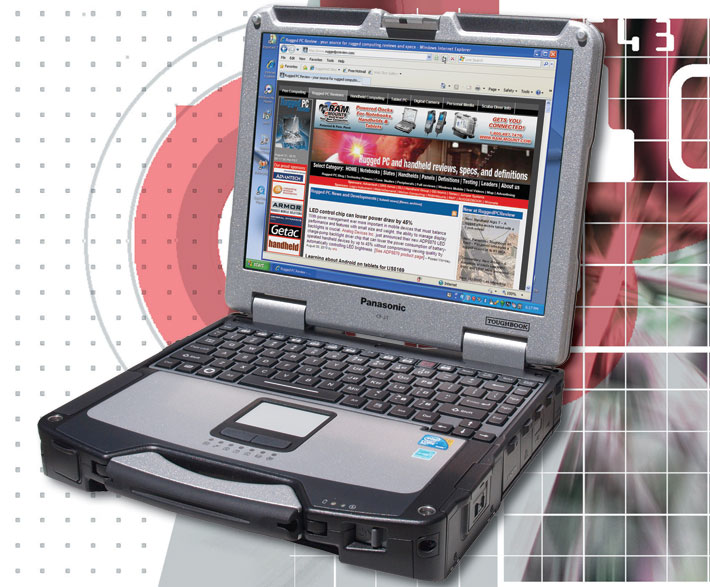
What's new in the Toughbook 31?
What has changed with the latest Toughbook 31 model? Most noticeably that Panasonic switched from Intel Core 2 Duo power to the latest Intel Core i3 and i5 processors. The three processors available in the new Toughbook 31, together with the new Mobile Intel QM57 Express chipset, are all part of Intel's "Calpella" platform. 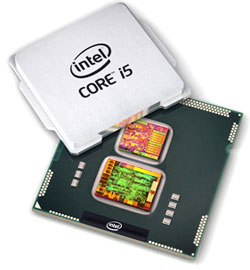 These 32nm lithography chips include the memory controller and fairly powerful integrated graphics with high definition video hardware acceleration right into the processor, and are essentially the successors of the Core 2 Duo CPUs.
These 32nm lithography chips include the memory controller and fairly powerful integrated graphics with high definition video hardware acceleration right into the processor, and are essentially the successors of the Core 2 Duo CPUs.
It gets a bit involved here as Intel offers a large variety of new Core i3, Core i5, and Core i7 processors and there are ultra low voltage, low voltage and standard voltage versions, with some designed for mobile use and some for the desktop. Of all these, Panasonic chose a "low end" Core i3 (the 2.26GHz Core i3-350M) and two higher end i5 chips (the 2.40GHz i5-520M and the slightly faster 2.53GHz i5-540M). Note that the latter two also have a "Turbo Boost" mode that automatically allows processor cores to run faster than the base clock frequency if the CPU is operating below power, current, and temperature specification limits. So the two i5 chips max out at 2.93 and 3.07GHz.
While the new processors are the big story, the Toughbook 31 benefits from new and ever better technologies in other ways as well: the capacities of the available shock-mounted and removable SATA hard disks are up to 160 and 250GB. That's perhaps a bit modest still as larger disks are now available. No argument, though, about the optional solid state disk -- who'd have thought a few short years ago that we'd have 256GB SSDs!? With the new processors, memory was switched to speedy 1066MHz DDR3, with a maximum of 8GB. An additional USB 2.0 port brings the onboard total up to 4, and there's now an HDMI port in addition to VGA.
Below you can see the older Panasonic Toughbooks of this series, starting with the CF-27 back in 1999.
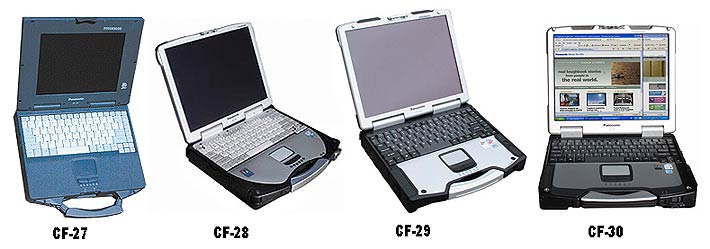
Design, look, and feel
Having followed the evolution of the Panasonic Toughbooks ever since I assumed the position of Editor-in-Chief of Pen Computing Magazine back in 1993, what impresses most is Panasonic's unerring, single-minded dedication to the ongoing improvement of the platform. It's a veritable quest for perfection, with Panasonic engineers agonizing over every tiny detail. There's no badge engineering here, no switching of suppliers (Panasonic makes virtually everything that goes into a Toughbook itself), no midstream course corrections, and no uncertainty about mergers or acquisitions or changes in policy. All of that combines to generate exemplary quality, exemplary longevity, and, perhaps most important of all, peace of mind for Toughbook customers.
There's really no describing just how solid a Toughbook feels, and how Panasonic somehow improved on the industrial design directive of "form follows function" by making form beautiful as well as functional. I sat in meetings with Panasonic engineers where they explained the "pencil hardness" of finishes and coatings, and how hardness relates to touch, abrasion and how they were shooting to improve hardness from 3H to 6H. I recall discussions of ph levels, and how acid from sweat may affect or break down plastics. It all matters, and the end result is a machine like the Toughbook 31. The powercoat finish of its LCD case is simply unbelievable, as is its design, and the design of the entire computer, down to the most minute detail.
But lets take a look at the matte-silver and black Toughbook, which measures 12 x 11.5 x 2.9 inches and weighs just under nine pounds. It's a big, substantial machine, though in an era of 17 and even 19-inch laptops, the 31 looks and feels downright svelte. Below you can see the top and all four sides of the machine:
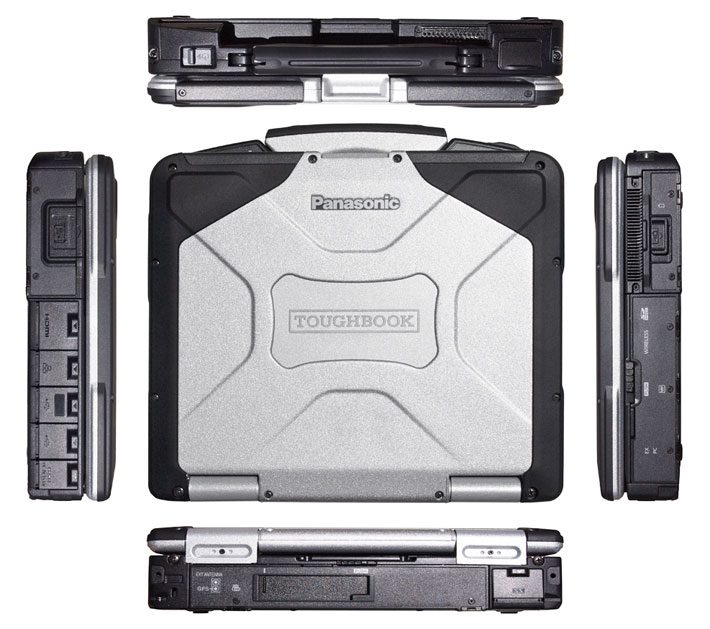
Ports and connectivity are spread around the machine including the front that features, besides the springloaded on/off/sleep lever, a fingerprint reader and the Toughbook-trademark magnesium carry handle that can now accommodate the supplied 5-inch-long plastic stylus. Note that all ports sit behind protective doors of various designs and technologies. Noteworthy here is that the Toughbook 31 now has positive "click-lock" port covers that offer more reliable sealing and protection. This design, where you first push a cover closed, then move it up until it locks with a noticeable snapping sound, was first seen on the Toughbook U1, and it's certainly an improvement over the older-style port covers.
The picture below shows the backside of the computer, with all of its ports exposed. On the right is a separately sealed RS-232 DB9 port for legacy support. The rest of the ports are all beneath a single hinged cover that includes a slider to provide access to the expansion bus and external antenna connectors. The door is secured with a spring-loaded latch that's a bit of a fingernail breaker. Also under the door are two USB 2.0 ports, an external display port and separate headphone and microphone jacks. To the left of the door is a Kensington standard slot so you can secure the Toughbook with a cable.
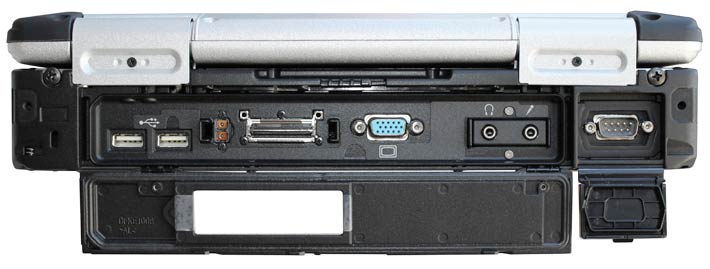
The two pictures below show the left (top) and right (bottom) side of the unit.
On the left side, two third are taken up by a large hinged door behind which you find the optical drive (in our unit a DVD writer), a PC Card Type II slot, an ExpressCard/54 slot, an SDHC card slot, a Smart Card slot, and a small wireless on/off switch that's well-enough hidden to potentially cause some anxiety when it's off and there isn't any wireless connection.
Next to it all is the lockable battery compartment and on top of that a ventilation hole for the Toughbook's fan. Yes, there is now a fan to deal with the extra heat of the powerful i5 processor, but it's small and innocuous and hardly ever seems to come on.
On the right side are no fewer than five separate separate doors. They protect an HDMI port, a SIM card slot, an RJ45 LAN port, an optional RJ11 modem port (people are still using modems?), two more USB 2.0 ports, and a power jack. To the left is the hard disk compartment whose door has both a latch and a security lock.
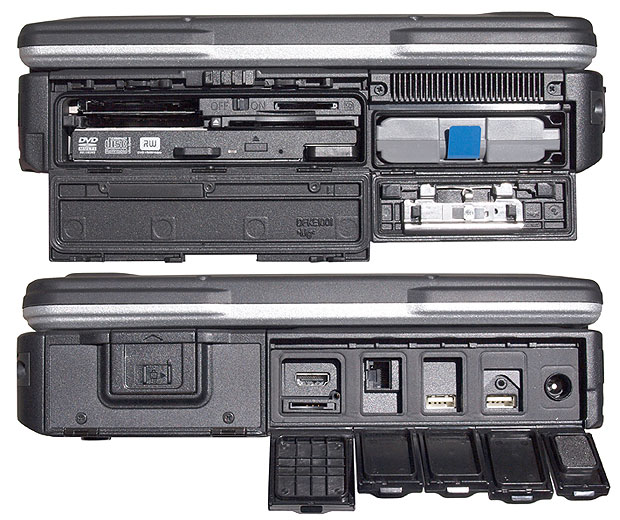 Worth mentioning is the way Panasonic designed the LCD case lock. This is important in rugged machines designed for outdoor use as the lock must be both strong and reliable enough to keep the computer from opening by accident, but also easy enough to operate so that it can be done with gloves on. To accomplish that, Panasonic designed a see-saw lock that solidly locks the LCD case against the main body of he computer with just a slight push, and also easily opens when pushed on the opposite end. The LCD case also has two small bolt-like bumps that fit into sleeved indents on the bottom part and preclude twisting of the LCD case when it's closed.
Worth mentioning is the way Panasonic designed the LCD case lock. This is important in rugged machines designed for outdoor use as the lock must be both strong and reliable enough to keep the computer from opening by accident, but also easy enough to operate so that it can be done with gloves on. To accomplish that, Panasonic designed a see-saw lock that solidly locks the LCD case against the main body of he computer with just a slight push, and also easily opens when pushed on the opposite end. The LCD case also has two small bolt-like bumps that fit into sleeved indents on the bottom part and preclude twisting of the LCD case when it's closed.
Keyboard and touch pad
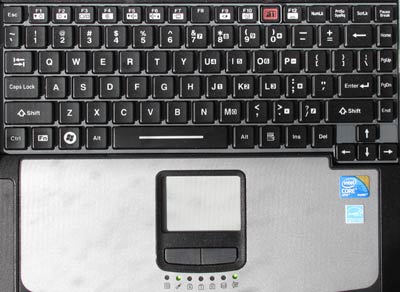 The Toughbook's keyboard is full-scale and has 87 keys. The fairly flat keys are black with white letters, numbers and symbols. The keys are backlit and go, via keyboard control, from off to full-bright in five steps. There is no separate keypad, but keypad functionality is available with the usual number keys assigned to the numbers 7, 8, 9, and the letters uio, jkl, and m. Overall, all those labels and icons make the keyboard look a little busy, but regular users will get the hang of it in no time. The Toughbook's keyboard is full-scale and has 87 keys. The fairly flat keys are black with white letters, numbers and symbols. The keys are backlit and go, via keyboard control, from off to full-bright in five steps. There is no separate keypad, but keypad functionality is available with the usual number keys assigned to the numbers 7, 8, 9, and the letters uio, jkl, and m. Overall, all those labels and icons make the keyboard look a little busy, but regular users will get the hang of it in no time.
Below the keyboard is the unit's touch pad. It is a small, recessed affair with the two mouse buttons in front of it. I am no big fan of this touch pad as it's so small that my fingers constantly bumped into its perimenter, and it also required a rather firm touch to get the cursor to move. There may be reasons for this design, but I'd prefer a larger and more cooperative touch pad. Beneath the touch pad assembly are seven indicator lights, each with an icon. I only recognized two without looking things up, so they are not terribly obvious. We criticized the Toughbook 27's equally small and unresponsive touchpad way back in 1999, and again in the reviews of the CF-29 and CF-30, and it's not clear why this is still an issue.
Panasonic must have had its reasons for this latest keyboard design, too, but there will be those who prefer the keyboards of older Toughbooks with their more legible large letters on gray and black keys and more commercial notebook design.
Performance
All notebook computers represent a compromise between performance, size, weight, battery life and cost. If you want a powerful processor with a lot of speed, that means more heat and less battery life. You can put in a bigger battery, but then the computer gets large and heavy. On the other hand, if you want a small, quiet computer without a fan, it will probably have much less performance. So, it's more speed, more heat, less battery life. Or more battery life, less performance, less heat. If you want more performance AND more battery life, it's more weight, AND more heat. So you can see that it's a compromise, and that's what Panasonic was facing when picking processors for this new version of the full-size Toughbook. In the past, Toughbooks usually had relatively low power processors that emphasized battery life.
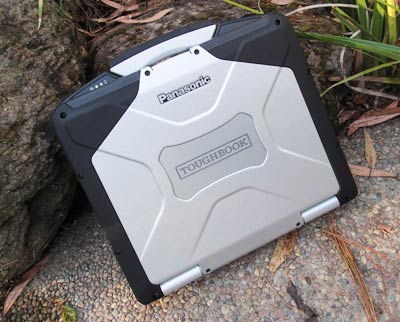 For the new Toughbook 31, however, Panasonic took a different approach and chose three rather high-powered chips in the 2.26GHz Core i3-350M, the 2.4GHz Core i5-520M, and the 2.53GHz Core i5-540M (present in our review machine). All three have a thermal design power of 35 watts, twice as much as the Core 2 Duo processor used in the Toughbook 30. These are what Intel calls "standard voltage" processors, as opposed to the low voltage and ultra-low voltage versions. Yet, for Core i5-powered Toughbook 31s, Panasonic claims even longer battery life than the already amazing ten hours specified for the predecessor Toughbook 30 with its lesser processor. Is that possible? For the new Toughbook 31, however, Panasonic took a different approach and chose three rather high-powered chips in the 2.26GHz Core i3-350M, the 2.4GHz Core i5-520M, and the 2.53GHz Core i5-540M (present in our review machine). All three have a thermal design power of 35 watts, twice as much as the Core 2 Duo processor used in the Toughbook 30. These are what Intel calls "standard voltage" processors, as opposed to the low voltage and ultra-low voltage versions. Yet, for Core i5-powered Toughbook 31s, Panasonic claims even longer battery life than the already amazing ten hours specified for the predecessor Toughbook 30 with its lesser processor. Is that possible?
It actually is. That's because Intel's new Core processors, while offering very impressive performance, are extraordinarily frugal thanks to advanced power savings techniques. So Panasonic is quoting 11 hours on a charge for Core i5 machines if using the integrated Intel graphics, and about 5 hours for an i5 machine running the discrete, switchable ATI Radeon graphics available with i5-540M models. Note that the fairly power-hungry discrete ATI graphics must be enabled in a BIOS setting.
To see what kind of performance the Core i5-540M-powered Toughbook 31 can deliver with and without discrete graphics engaged, we ran our standard benchmark suite, Passmark Software's PerformanceTest 6.1, that runs about 30 tests covering CPU, 2D graphics, 3D graphics, memory, and disk and then computes scores for each category and an overall PassMark score. We also ran our second benchmark suite, CrystalMark, for confirmation and additional information. For comparison, we included the benchmarks of two direct competitors with late model Core 2 Duo processors, the Getac B300 currently still with an older version of the Core 2 Duo, and the Motion J3500 tablet computer with an ultra-low voltage Core i7 processor.
|
PERFORMANCE COMPARISON
|
Panasonic
|
Panasonic
|
GD-Itronix
|
GD-Itronix
|
Motion
|
Getac
|
|
Model
|
31 (Intel graphics)
|
31 (ATI graphics)
|
GD8000
|
GD6000
|
J3500
|
B300
|
|
Processor
|
Intel Core i5 M540
|
Intel Core i5 M540
|
Intel Core 2 Duo SL9400
|
Intel Core 2 Duo T9400
|
Intel Core i7 U640
|
Intel Core 2 Duo L7500
|
|
CPU Speed
|
2.53GHz
|
2.53GHz
|
1.86GHz
|
2.53GHz
|
1.20GHz
|
1.60GHz
|
|
Thermal Design Power (TDP)
|
35.0 watts
|
35.0 watts
|
17.0 watts
|
35.0 watts
|
18.0 watts
|
17.0 watts
|
|
CPU Mark
|
1008.8
|
997.3
|
1185.5
|
1538.8
|
699.2
|
893.9
|
|
2D Graphics Mark
|
249.6
|
263.1
|
102.1
|
294.8
|
181.5
|
158.5
|
|
Memory Mark
|
737.7
|
727.0
|
559.0
|
696.8
|
502.5
|
400.0
|
|
Disk Mark
|
589.1
|
590.4
|
372.6
|
378.0
|
1004.1
|
343.3
|
|
3D Graphics Mark
|
352.3
|
487.5
|
52.7
|
180.7
|
276.1
|
138.3
|
|
Overall PassMark
|
600.2
|
613.5
|
518.8
|
679.5
|
538.6
|
420.8
|
|
ALU
|
34170
|
34258
|
18527
|
24808
|
23294
|
14320
|
|
FPU
|
37566
|
37321
|
19617
|
26781
|
21721
|
16990
|
|
MEM
|
24259
|
24657
|
14381
|
16651
|
17025
|
10148
|
|
HDD
|
8629
|
8950
|
7109
|
6920
|
28029
|
6711
|
|
GDI
|
5910
|
6300
|
6947
|
7966
|
6862
|
2565
|
|
D2D
|
5656
|
1530
|
3100
|
3566
|
1416
|
4535
|
|
OGL
|
2701
|
11318
|
1552
|
1936
|
1694
|
1020
|
|
Overall CrystalMark
|
118891
|
124334
|
71233
|
88628
|
100041
|
56289
|
The PassMark results are somewhat surprising as the machines with the low and standard voltage Core 2 Duo 9400 processor neatly bracketed the i5-powered Toughbook 31, with the ultra-low voltage i7-powered Motion tablet running at just 1.2GHz not being far behind. In the CrystalMark benchmarks, however, the Toughbook's fast standard voltage i5 clearly established supremacy.
Also note that in both benchmarks, the Toughbook scored by far the highest 3D and OGL graphics results. In default mode with just the i5 processor's integrated graphics, the 3D and OGL results were quite good, but for any application that is heavy on 3D graphics, and especially OGL code, it definitely pays to enable the discrete ATI graphics. OpenGL (Open Graphics Library) refers to a cross-language, cross-platform API for 2D and 3D graphics and is widely used in CAD, simulations and visualizations. As is evident from the benchmark results, engaging the ATI Radeon processor not only boosts standard graphics, but provides phenomenal OGL performance.
Either way, the Toughbook 31 is a very good performer, and by far the fastest full-size fully rugged Toughbook yet.
The new hybrid cooling system
Nothing is ever totally free, of course, and that also applies to the performance of the new Intel chips. By picking "standard voltage" processors that would offer the best performance possible while still meeting the battery life goals, Panasonic had to deal with handling a "Thermal Design Power" (TDP) of 35 watts, more than twice the predecessor machine's SL9300 low voltage chip.
 Thermal design power is the maximum amount of power a computer's cooling system needs to dissipate and is used by Intel as a measure of power efficiency. So while the new chips run very efficiently, they can still generate a lot more heat than the old ones, and that heat must be dissipated. So bye-bye fan-less design. Panasonic doesn't point this out specifically, but mentions their new "hybrid cooling system," where hybrid means that a fan is helping the internal heat piping to dissipate the heat generated by the processor. That's not the end of the world; Itronix has been using fans for years, and they're totally waterproof, and so is the one in the Toughbook 31. It's still less elegant, but thus is progress. The Panasonic website shows a video of the fan handling both water and muddy gunk (see above). Thermal design power is the maximum amount of power a computer's cooling system needs to dissipate and is used by Intel as a measure of power efficiency. So while the new chips run very efficiently, they can still generate a lot more heat than the old ones, and that heat must be dissipated. So bye-bye fan-less design. Panasonic doesn't point this out specifically, but mentions their new "hybrid cooling system," where hybrid means that a fan is helping the internal heat piping to dissipate the heat generated by the processor. That's not the end of the world; Itronix has been using fans for years, and they're totally waterproof, and so is the one in the Toughbook 31. It's still less elegant, but thus is progress. The Panasonic website shows a video of the fan handling both water and muddy gunk (see above).
Power and Battery Life
So by now we have established that the Toughbook is an excellent performer, but how does that mesh with the 11 hour battery life Panasonic quotes? After all, the potent i5-540M processor alone has a thermal design power of 35 watts. Apply that to even a big battery like this Toughbook's 91 watt-hour Li-Ion pack, and you'd expect it to get drawn down pretty quickly.
 But it's not. That's because Intel's new Core processors include excellent power management that lets them throttle down and idle along when full or even partial performance isn't needed. We used PassMark's BatteryMon to measure power draw and found that, as has been the case with other Panasonic machines we've tested, battery draw constantly fluctuates up and down. But it's not. That's because Intel's new Core processors include excellent power management that lets them throttle down and idle along when full or even partial performance isn't needed. We used PassMark's BatteryMon to measure power draw and found that, as has been the case with other Panasonic machines we've tested, battery draw constantly fluctuates up and down.
The graph to the right shows power draw with the machine set to maximum battery conservation, wireless radios off, screen brightness way down, and the machine just idling along. That way we saw draws below eight watts, which is practically Atom processor territory. And it'd indicate battery life of well over nine hours. However, with power draw constantly fluctuating, the average draw was probably more like 10 to 12 watts.
With radios on, screen brightness normal, and running 1080p video the machine got a good workout and power draw rose to fluctuating between 22 and 35 watts, with an average of about 26 watts. So going full blast, battery life would drop to something over three hours, which is still quite acceptable.
In real life, most machines alternate between brief periods of heavy use, periods of moderate use, and a lot of idling, during which the computer will likely go into standby mode. In our testing, Windows 7 does a much better job at that than Windows XP, and for that reason alone we'd rather see Windows 7 on the Toughbook 31 than the XP our tester had. Windows 7 also seems exceptionally well matched to the new Core processors' hardware power conservation measures.
Note that power draw is significantly higher with ATI discrete graphics engaged. When we set the BIOS to "Performance Video" to run a second set of benchmarks, minimum power draw jumped from less than eight watts to 13 watts. In essence, Toughbooks with the Core i5-540M and discrete ATI graphics are a little like cars with a big turbocharger: you get great mileage when the turbo is off, but step on it and there's a price for the extra performance.
Overall, the Toughbook 31 is a fast machine that, unlike speed demons of the past, still manages to make its battery last a good long time.
Display
On the display side, the old-style 4:3-ratio 13.1-inch display may raise a few eyebrows in an era where everything's been switched to 16:10 or even 16:9 wide-format. According to Panasonic, that was necessary to preserve docking hardware compatibility and the same 1024 x 768 XGA display resolution also means that custom software won't have to be rewritten. That may be so, but at this point we'd like to see a somewhat higher and more contemporary resolution that will allow the big Toughbook to run modern apps that require much higher resolution.
Panasonic, an early pioneer in daylight viewability with its DayBrite ARX, now calls its outdoor-readable display technology "CircuLumin," a bit of a tongue twister of a term that describes a combination of anti-glare and anti-reflective coatings, and circular polarizers that makes the display usable outdoors. Combine that with a super-powerful backlight, and the Toughbook 31 can be used under pretty much all lighting conditions. What's new for the 31 is LED backlight, which brings an additional 10% increase in brightness: you can now crank the display up to 1,100 nits (compared to about 200 for a standard notebook). Another benefit of the LED backlight is that it can be turned down as low a two nits whereas the old CCFL backlight went no lower than seven nits, which was still too much when you did not want to be seen.
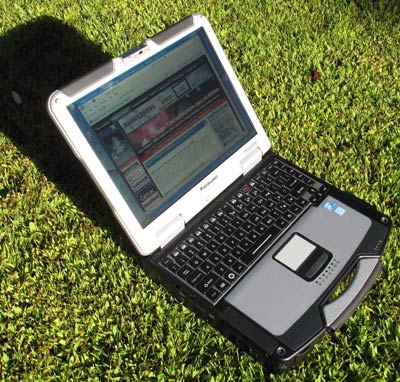 Another screen issue: all Toughbook 31 models come with a touch screen. It's no longer an extra-cost option as it was with earlier models. It's still resistive, so no cursor tracking as you can do with Wacom-style active digitizers, and no multi-touch yet. Panasonic is working on it, though (the Toughbook C1 already has it). Another screen issue: all Toughbook 31 models come with a touch screen. It's no longer an extra-cost option as it was with earlier models. It's still resistive, so no cursor tracking as you can do with Wacom-style active digitizers, and no multi-touch yet. Panasonic is working on it, though (the Toughbook C1 already has it).
And more news in the display and graphics: Intel's 2010 Core processors are inherently capable of driving multiple monitors in any combination of Display Port, HDMI, DVI and VGA, and even offer dual simultaneous HDMI support. Not all of this is implemented on the Toughbook 31, of course, but it is good to have the HDMI port to make HD presentations and such.
I already mentioned that the new Core i3 and i5 processors used in the Toughbook 31 have integrated graphics that are said to provide about 1.5 times the graphics performance of the predecessor GM45 platform in an equivalent Core 2 Duo processor, with much better 3D performance, HD hardware acceleration, post processing, audio and other improvements. But Panasonic offers even more: models with the i5-540M processors come with additional discrete graphics via an ATI Radeon HD5650 graphics processor.
Real-world outdoor display performance
Figures, technologies and numbers are one thing, but actually using a display outdoors in bright sunshine and under various lighting conditions is another. The pictures below are a side-by-side comparison between the 13.1-inch Toughbook 31 screen and that of one of our office notebooks, a standard-issue Gateway machine. It's not really a fair comparison because the Gateway is just an ordinary notebook whereas the Toughbook is a highly specialized computer for outdoors applications. However, the Gateway display is actually very good, remains readable outdoors, and sports one of those modern high-gloss screens that are now practically everywhere. So what can we learn from the comparison?
The first picture below shows the two machines outside in broad daylight, but not in direct sunlight. Here you can see the brute power of the Toughbook's 1,100 nit backlight. For actual use we'd have to crank down the backlight as it is almost too bright, even for outdoors. It's also very, very noticeably brighter than the Gateway, which remains quite readable but is much dimmer even though its backlight is actually quite strong for a standard notebook.
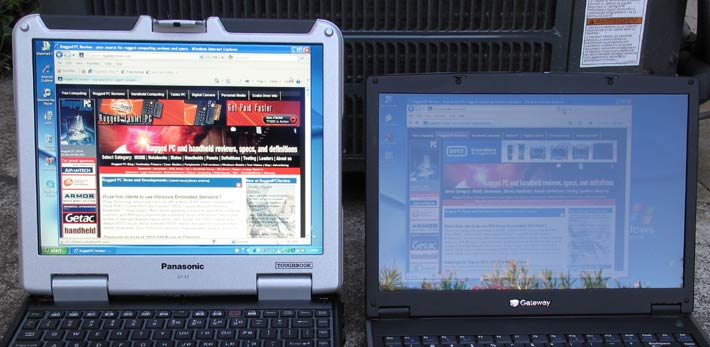
The next comparison picture shows the two computers from an angle, and here you can see what reflections can do to a display. The Gateway's glossy screen acts like a pane of glass, reflecting the scenery and rendering the display almost useless. The Toughbook's display is totally unaffected. Its very effective anti-reflective and anti-glare coatings and the use of circular polarizers make for a rock-solid picture that remains perfectly readable.
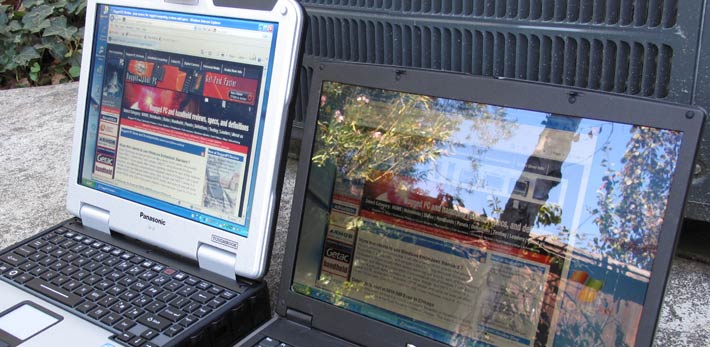
Next a picture from the other side. Here you can see the combined effect of the Toughbook's very strong backlight and its optical treatments. The bottomline is that the Toughbook display's coatings are probably about as good as it currently gets, and the screen is so bright that it provides the kind of pleasant "indoor" look even in fairly bright daylight.
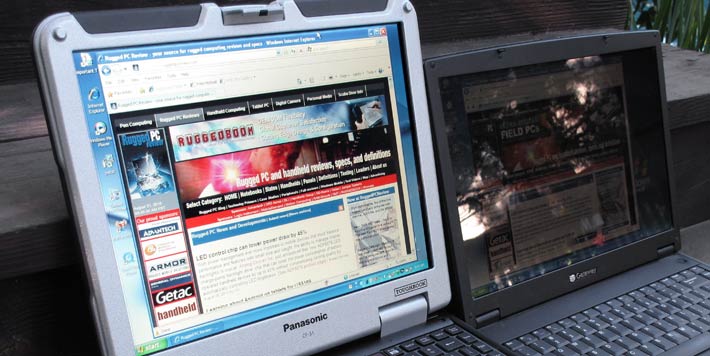
Overall, the Toughbook's display hasn't changed in a good number of years. It's gotten more easily readable and a whole lot brighter thanks to the very powerfulbacklight, and that's good. But Panasonic's decision to keep the latest Toughbook compatible with all the older docks and applications means it's still a 4:3 aspect ratio 13.1-inch display with very modest XGA resolution. At some point, the company will have to take the step to a more contemporary display size and higher resolution. It's inevitable.
Wireless considerations
Properly measuring radio frequency radiation emitted from a computer equipped with wireless radios isn't simple because there are just so many radio waves around. 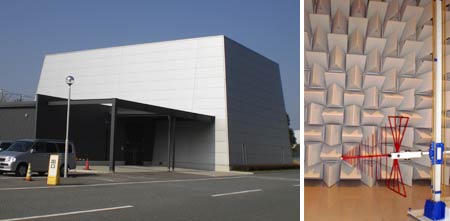 The solution is to do the testing in an "anechoic" RF isolation chamber that's completely shielded from all external interference. At their Kobe Toughbook factory, Panasonic has its own special anechoic chamber building (shown in the picture to the right) whose construction required a floor of welded steel plates, a double layer of copper shielding on the walls and ceiling, and complete suppression of interior reflection of radio waves via hundreds of wedge-shaped urethane RF absorption modules. Inside this special space Panasonic's engineers were then able to reliably measure RF performance and assure compliance with the permissible radio interference standards across the globe. The solution is to do the testing in an "anechoic" RF isolation chamber that's completely shielded from all external interference. At their Kobe Toughbook factory, Panasonic has its own special anechoic chamber building (shown in the picture to the right) whose construction required a floor of welded steel plates, a double layer of copper shielding on the walls and ceiling, and complete suppression of interior reflection of radio waves via hundreds of wedge-shaped urethane RF absorption modules. Inside this special space Panasonic's engineers were then able to reliably measure RF performance and assure compliance with the permissible radio interference standards across the globe.
Modern mobile computers rely on strong onboard wireless radio performance, and the Toughbook 31 is no exception. All versions come with integrated Bluetooth v2.1 with enhanced data rate. Models equipped with Core i5 processors come with Intel Centrino Advanced-N 6200 802.11a/b/g/n WiFi modules, whereas Core i3 models have an Atheros AR9285 802.11b/g/n WiFi module.
Optionally available for all models is integrated Gobi 2000. Gobi stands for Global Mobile Internet technology, and is a Qualcomm wireless technology that supports the various wireless networking standards around the world, so users can select whatever carrier is available to them (see Qualcomm page on Gobi). Gobi 2000, in addition to current wireless technologies, also supports emerging 4G standards. With the Panasonic Carrier Selection Application (CSA) software platform, there is no more need to physically switch out various single-module, carrier-specific modems to select a different carrier. With Gobi, Toughbook users in the US can access AT&T, Sprint and Verizon Wireless networks with one wireless device, and select or change to the best carrier for any geographic area.
Also available as an integrated option is a GPS receiver (which our device did not have).
A look inside the Toughbook 31
Panasonic prides itself on its extremely low failure rates. That's due in part to the many years of experience Panasonic has in making Toughbooks as bullet-proof as possible. But it's also a testimony to the extremely high quality of the product, quality that is instantly evident when you look inside the machine. There's no cutting corners here. Every detail has been thought out, properly engineered, and then improved until it's just right. 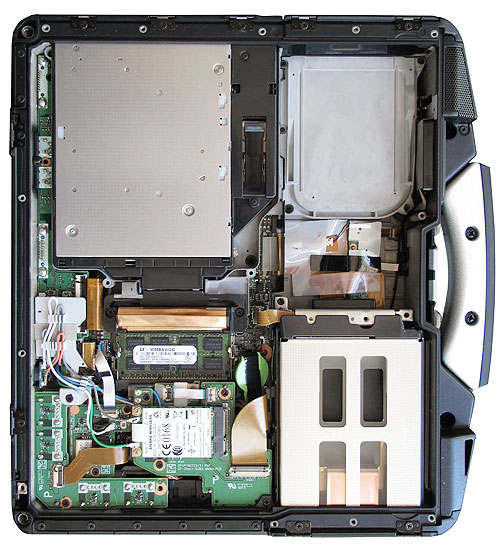 There are details that you simply don't find anywhere else. For example, even well engineered systems usually have some loose wires inside. Not this one. Panasonic actually designed little plastic boards that hold and route all the wires from add-on modules such as the Sierra Wireless Gobi2000 module. There are details that you simply don't find anywhere else. For example, even well engineered systems usually have some loose wires inside. Not this one. Panasonic actually designed little plastic boards that hold and route all the wires from add-on modules such as the Sierra Wireless Gobi2000 module.
The picture to the right shows the bottom inside of the Toughbook 31 after the lightweight magnesium cover with all its details, cutouts, reinforcements and integrated o-ring seal has been removed. Things are complex in there, with multiple boards and modules stacked on top of each other, very precisely fitting into the tough magnesium housing and a number of strong magnesium subframes.
Complex though it is, the guts of the Toughbook 31 are also very modular. Sub-boards are easily removed and replaced, which presumably makes customizing easy. The hard disk easily slides in and out. The media bay likewise is easily accessible. Everything looks like it's the result of many years of optimizing and working out all the bugs.
The overall chassis of the Toughbook 31 is, of course, made of magnesium, a metal whose use in notebooks Panasonic pretty much pioneered. Magnesium is light, readily available, conducts well, shields electromagnetic waves, and is easily recyclable. Panasonic can now produce thin cast magnesium alloys that are just 0.02 inches thick, thinner than most plastics. 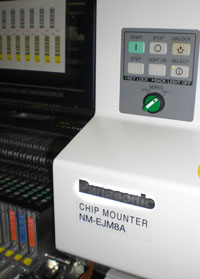 Parts of the chassis and sub-frames are so thin that it is hard to believe they are made of metal. Yet, they are completely rigid and incredibly strong. The attention to detail extends evertwhere. The cover of the wireless module and memory access bay uses three different kinds of foam rubber. There's a custom-cut gasket for sealing that is wide enough to always make a reliable seal. There's a dense spacer designed to always keep the memory module in place (not that it looks like it'd ever get loose), and on top of the spacer is a much softer piece of foam rubber so that there is not too much pressure on the memory module. Parts of the chassis and sub-frames are so thin that it is hard to believe they are made of metal. Yet, they are completely rigid and incredibly strong. The attention to detail extends evertwhere. The cover of the wireless module and memory access bay uses three different kinds of foam rubber. There's a custom-cut gasket for sealing that is wide enough to always make a reliable seal. There's a dense spacer designed to always keep the memory module in place (not that it looks like it'd ever get loose), and on top of the spacer is a much softer piece of foam rubber so that there is not too much pressure on the memory module.
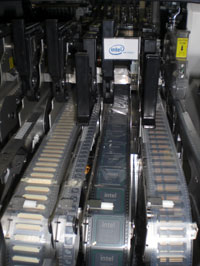 The boards and assembly are as clean as can be. All Toughbook 31 computers are made in Panasonic's Kobe factory, a state-of-the-art facility where a very skilled workforce combines with the most advanced industrial robots to create pretty much the ultimate in manufacturing quality and efficiency. The factory, which also makes Panasonic's semi-rugged and business-rugged tablets and computers, is a veritable case study in optimal deployment of full automation, automated processes that require supervision, and processes that rely on skilled manual labor. Many of the robots and machines have red and green indicator lights that are green when things are running smoothly, but turn red to alert technicians to a problem or anomaly that requires intervention. The boards and assembly are as clean as can be. All Toughbook 31 computers are made in Panasonic's Kobe factory, a state-of-the-art facility where a very skilled workforce combines with the most advanced industrial robots to create pretty much the ultimate in manufacturing quality and efficiency. The factory, which also makes Panasonic's semi-rugged and business-rugged tablets and computers, is a veritable case study in optimal deployment of full automation, automated processes that require supervision, and processes that rely on skilled manual labor. Many of the robots and machines have red and green indicator lights that are green when things are running smoothly, but turn red to alert technicians to a problem or anomaly that requires intervention.
Unlike most computer manufacturers, Panasonic doesn't buy boards somewhere else. They are made right in that factory. And it doesn't even stop there. Most of the machines are designed and made by Panasonic, too, including the chip insertion machine (see picture to the right) that Panasonic says is the fastest in the business. It's fascinating to watch these machines being fed chips and circuits like ammunition in a Gatlin machine gun (see picture to the left), with the chips disappearing into the machine and then being precision-mounted onto the circuit boards.
Looking at the inside of the Toughbook 31, you may wonder where the fan is. After all, the machine must dissipate the heat of a powerful 2.53GHz Core i5 processor with a thermal design power rating of a full 35 watts. That's where Panasonic's many years of expertise in thermal engineering come in. The CF-31 does have a fan, but it's just a small one, housed in a magnesium enclosure that's completely sealed to the inside. An elaborate system of copper heat pipes conducts the heat away from chips and components, and the very sturdy magnesium case itself is a heat sink. 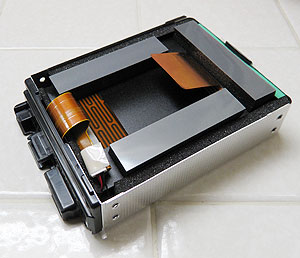
The hard disk is removed in the picture above, but you can see where it sits on the right side of the board. Hard disks are notorious points of failure due to drops and impact, and so Panasonic spent a lot of time coming up with the best possible solution. While the hard disks in many rugged computers have some sort of shock absorption, the protective hard disk enclosure used in the 31 is in a class of its own.
The disk isn't just shock-mounted, but it sits inside its own removable caddy. And that caddy isn't just a plastic frame with a bit of padding, it is an intricate metal box inside of which, completely enclosed in foam padding and buffers, sits the hard disk. And this isn't just any foam; it is a special type of slow-collapsing foam that Panasonic developed especially for this very purpose. This means that in a typical drop, the kind that can and will happen in the field, the impact on the disk is reduced from thousands of Gs to just a small fraction of that, well within what the 31's hard disk can handle while operating.
Note that the disk caddy is easily removable from outside. Just open the door on the side of the computer and pull it out. In the past, that sort of arrangement would have been a cause for concern (theft, etc.). Today, easy removal is a must as in many deployments hard disks are retrieved from computers and safely locked away when the machines are not in use.
More rugged than ever
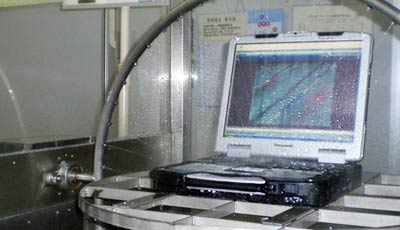 As far as ruggedness goes, Panasonic continues to push the boundaries. It was always clear that Panasonic's rugged Toughbooks could take a substantial beatings, but in earlier generations that wasn't always reflected in impressive ruggedness specs. As a result, not too long ago, the predecessors of the new Toughbook 31 really only qualified as "semi-rugged." As far as ruggedness goes, Panasonic continues to push the boundaries. It was always clear that Panasonic's rugged Toughbooks could take a substantial beatings, but in earlier generations that wasn't always reflected in impressive ruggedness specs. As a result, not too long ago, the predecessors of the new Toughbook 31 really only qualified as "semi-rugged."
That has changed. Sealing is now up to IP65 standards (with the "6" meaning the machine is totally protected against dust, and the "5" that it's protected against low pressure jets of water from all directions. Kyp Walls pointed out that the newly designed port covers that click-lock into place provide substantially better sealing.

Panasonic now also claims an almost incredible 6-foot drop spec, measured in accordance with MIL-STD-810G Transit Drop procedures. That is extremely impressive. It means that a test machine, turned off, was subjected to 26 drops (one drop on each face, edge and corner) from 72 inches onto plywood. The MIL-STD requests "Following completion of the required drops, visually examine the test item(s), and document the results" and "conduct an operational checkout". According to Panasonic's test report summary, the machine passed that test.
While being able to survive a 6-foot drop 26 times seems unreal for such a large and heavy piece of electronic equipment, I've seen the Panasonic engineers' meticulous attention to every smallest details with my own eyes at the Panasonic factory in Kobe, and so somehow they managed to combine all those special materials, shock absorption techniques, special subframes, etc., etc., into a computer that can take more punishment than should be possible.
Panasonic also deserves big kudos for making publicly available all of its ruggedness testing documents right on its Toughbook 31 web page.
Security
With notebook computers now being used almost everywhere, machines are entrusted with more and more information, including mission-critical data. This makes security a primary concern, and so Panasonic equipped the Toughbook 31 with several physical and software security measures:
- There are the optional fingerprint and Smart Card readers that can be used as a very effective ways to complement, reduce or eliminate multiple passwords.
- Core i5 models include the TPM 1.2 micro controller with cryptographic functionality that allows the creation and management of computer-generated digital certificates. Combined with software, they can send and receive secure email, set up the browser for client identification, sign Word macros, encrypt individual files or entire folders, and create secure network connections.
- The Computrace theft protection agent is in the BIOS.
- The security menu in the BIOS also allows setting passwords for hard disk lock as well as configuration for embedded security, fingerprint reader settings, and Intel AMT configuration.
- And don't forget physical security via a Kensington-style locking cable. Simple, but effective.
Remote management with vPro
In the Toughbook 31 webpage, Panasonic highlights vPro, available with the two i5 processors used in the Toughbook 31, and dedicates a detailed video to it.
The video shows the use of vPro technology between a dispatch with a vPro console and a Toughbook-equipped service truck. It demonstrates how the remote console can wake up the Toughbook, run a job, then shut it down again.
So what is vPro all about?
vPro is an Intel technology platform that allows remote access to a PC regardless whether the computer is booted up or the power is even on. It is intended to allow remote management, monitoring and maintenance while maintaining strict security measures. While vPro componentry needs to be included in the processor, it's a platform rather than just a technology feature, one that requires a combination of chip, board, firmware and software. vPro also includes other Intel technologies such as Intel AMT (Active Management Technology), Intel Virtualization Technology, Intel's TXT (Trusted Execution Technology) and, of course, a network connection.
While remote access and management of PCs is commonly available through software such as VNC, VNC alone may not be capable and secure enough for all corporate purposes. With vPro, VNC can still be used, but it is now the Intel AMT part that facilitates secure communication with the PC, and in conjunction with the whole vPro platform, it is not only possible to control a remote PC, but also to start it up and—even more amazingly—log in and perform certain functions even if the OS is corrupted or missing. That's because the vPro engine/platform is available at a very low system level.
How can such vPro-based remote access be used? Well, there could be a system where dispatch sends job requests to the Toughbook 31 in a truck. The request will boot the computer if it is off, and then either perform a job or prompt the operator in the truck to do the job and report back. It can then turn off the computer remotely, even shut down the OS. As long as the computer still has power, it remains remotely accessible (remotely waking up a PC is usually done via a hardwire LAN connection, so Panasonic probably used a vehicle access point with hardwire LAN).
It's an interesting technology, and a great example of how new features can be used to make mobile notebooks ever more useful. (See vPro page at Intel).
Summary: The Panasonic Toughbook 31
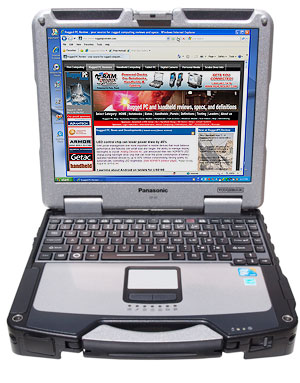 The Panasonic Toughbook 31 is a rugged 9-pound notebook computer now in its sixth generation. It's a full-size workhorse of a computer and a platform that's mature and proven in numerous applications around the world. This latest model remains fully vehicle dock compatible with all full-size Toughbooks since the CF-27, and its unchanged display size and resolution means all custom software remains fully compatible as well.
The Panasonic Toughbook 31 is a rugged 9-pound notebook computer now in its sixth generation. It's a full-size workhorse of a computer and a platform that's mature and proven in numerous applications around the world. This latest model remains fully vehicle dock compatible with all full-size Toughbooks since the CF-27, and its unchanged display size and resolution means all custom software remains fully compatible as well.
While the lastest Toughbook looks pretty much the same as its Toughbook 28, 29 and 30 predecessors, this is by far the fastest Toughbook ever thanks to the switch to Intel's Core i3 and i5 processors. These chips are energy-efficient enough for Panasonic to go with more powerful "standard voltage" versions and still get very good battery life. Our machine came with Windows XP, but we'd definitely recommend Windows 7 now.
The Toughbook's 13.1-inch display still only has XGA resolution in the old 4:3 aspect ratio format, but it now has even brighter 1,100 nit LED backlighting. Combined with a variety of optical treatments, the display offers excellent outdoor viewability.
Panasonic also beefed up ruggedness yet again, this time boosting the ingress protection rating from IP54, where limited ingress of sand and water was still permitted, to IP65, which means the computer is totally dustproof and protected against water jets from all directions. Even more impressively, this big Toughbook now has an incredible 6-foot drop spec rating.
A touch screen is now standard and it's quick and responsive. We're less enamored with the busy-looking rubber keyboard and its flat keys, and the touch pad remains small and hard to operate.
Design, finish, and execution of Panasonic Toughbook 31 remain unmatched in most respects, and the machine certainly is a very attractive upgrade proposition for existing Toughbook customers, as well as a prime contender for any application anywhere that requires full computing power and extra toughness.
Panasonic Toughbook 31 highlights:
- Significantly enhanced 5th generation of the premier Panasonic Toughbook
- Exceptionally solid and well-made
- Much improved performance with Intel Core i3 and i5 processors
- Very bright display with excellent outdoor viewability
- Superb 3D and OGl graphics performance with discrete ATI Radeon graphics engaged (i5-540M only)
- Excellent glare and reflection control
- Improved sealing via new protective door designs
- Very responsive touch screen now standard
- Optional Gobi 2000 provides global wireless access
- New LED backlight even brighter and less sensitive to low temperatures
- Full vehicle dock compatibility with virtually all predecessor Toughbooks
- HDMI port and optional vidcam
- Incredible 6-foot drop spec!
But keep in mind:
- 4:3 aspect ratio XGA display now feels dated
- Small, unresponsive touch pad remains
- Busy looking keyboard and icons
- There is now a fan
- Battery life takes a dive with discrete graphics engaged
– Conrad H. Blickenstorfer, September 2010
Update May 25, 2011: Panasonic announced a series of upgrades to its Toughbook 31 with new Intel Core i5 (2520M/2540M) and i3 (2310M) processors, increased RAM and hard drive capacity (320GB standard now) as well as speed, up to 20 hours of battery life wWith the optional extended life media bay battery), a brighter sunlight-viewable screen (from 1,110 to 1,200 nits) and more (like newer WiFi, SDXC card, optional 4G LTE, optional USB 3.0). The availability of discrete graphics from an ATI Radeon HD6750 card (instead of HD5650) also delivers significant improvements in 3D graphics. Pricing now starts at US$3,299 (down from US$3,799).
|
Panasonic Toughbook 31 Specifications
|
| Added/changed |
Added 5/2010, full review 9/2010
|
| Type |
Rugged notebook computer
|
| Processor |
Intel Core i3-350M, i5-520M, i5-540M |
| CPU speed |
2.26g GHz, 2.40GHz (2.93 with Turbo Boost), 2.53GHz (3.07 with Turbo Boost) |
| OS |
Windows 7 Professional (with Windows XP downgrade option) |
| Graphics Controller/Chipset |
Integrated into CPUs; models with i5-540m processor come with additional ATI Radeon HD5650 discrete graphics |
| Memory |
2-8GB DDR3 1066MHz SDRAM |
| Display |
Daylight-readable transmissive TFT with 1100 Nit LED backlight and Panasonic CircuLumin technology: circular polarizer, anti-glare and anti-reflective coatings
|
| Display size and resolution |
13.1" XGA (1024 x 768 pixel)
|
| Digitizer/Pens |
Resistive Touch
|
| Keyboard |
Integrated 87-key, 100%-scale; optional 6-step backlight |
| Storage |
160 (350M and 520M models) or 250GB (540M model) shock-mounted, removable SATA hard disk, or optional 256GB SSD |
| Multimedia Pocket |
Multimedia pocket accepts optional DVD Super Multi Drive or 2nd battery |
| Slots |
1 Type II PC Card, 1 SD Card, 1 Express Card (54mm), SmartCard (opt.) |
| Housing |
Magnesium alloy |
| Temperature |
MIL-STD-810G, Method 501.5, Procedure II -140F Operating; MIL-STD-810G, Method 502.5, Procedure II -- -20F Operating |
| Humidity |
MIL-STD-810G, Method 507.5, Procedure II (Aggravated) -- Temp. cycles 86F to 140F; 95% RH |
| Vibration |
operating: MIL-STD-810G, Method 514.6, Procedure I; non-operating: MIL-STD-810G, Method 514.6, Procedure I (Transportation) |
| Sand and Dust |
MIL-STD-810G, Method 510.5, Procedure I |
| Explosive Atmosphere |
MIL-STD-810G, Method 511.5, Procedure I |
| Enclosure Class |
IP65 |
| EMI |
MIL-STD-461F |
| Shock: Functional |
MIL-STD-810G, Method 516.6, Procedure I -- 40g, 11ms Operating |
| Shock: Transit Drop |
MIL-STD-810G, Method 516.6, Procedure IV -- 26 drops - 72in height on to 2in plywood - non operating (all drops performed on the same unit that was also subjected to all 48-in and all 60-in drops) |
| Certifications |
Section 508, Energy Star, EPEAT, ISO, RoHS, UL1604 |
| Size (inches) |
11.9 x 11.5 x 2.9 inches |
| Weight |
8.9 pounds as tested, with battery, handle and optical drive |
| Power |
10.65V/8,550mAH (91 watt-hour) Li-Ion battery |
| Communication |
Bluetooth v2.1 + EDR, Intel Centrino Advanced-N 6200 802.11a/b/g/n (i5 CPU models), Atheros AR9285 802.11b/g/n (i3 CPU model) |
| Interface |
Port replicator, HDMI, VGA, headphones/speaker, microphone/line in, 1 x RS232 DB9, ext. antenna connector, 4x USB 2.0, gigabit LAN (i5 models have two);optional: IEEE 1394a FireWire and 56k modem
|
| Price |
Starting at US$3,799 (street price base model) |
| Website |
Panasonic Toughbook 31 |
|
| |



